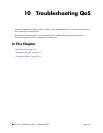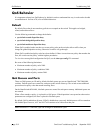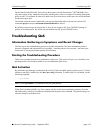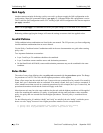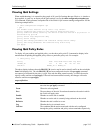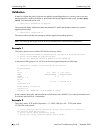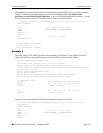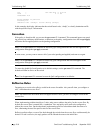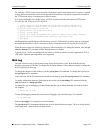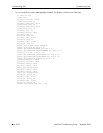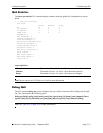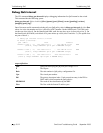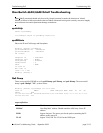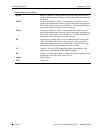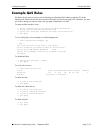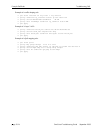
Troubleshooting QoS Troubleshooting QoS
OmniSwitch Troubleshooting Guide September 2005 page 10-9
For example, a TFTP session in one direction will prompt a reply back from the host. If a policy is created
to deny traffic from that host to the switch, the replies from the host will still be accepted on the switch if
the TFTP session policy is configured as a reflexive policy.
If we do not define the rule “oktftp” below, no TFTP session would take place between TFTP client
192.168.10.4 and TFTP server 192.168.20.10.
-> policy condition noip destination ip 192.168.10.0 mask 255.255.255.0
-> policy condition oktftp source ip 192.168.10.0 mask 255.255.255.0 ip
protocol 17 destination ip port 69
-> policy action noip disposition deny
-> policy action oktftp
-> policy rule oktftp precedence 200 condition oktftp action okftp reflexive
-> policy rule noip precedence 100 condition noip action noip
-> qos apply
Another problem could be that the reflexive timer is too low. When reflexive policy rules are configured
and traffic that matches a reflexive rule arrives on the switch, the switch will wait for the reverse flow.
When the timer expires, the reflexivity will not be effective anymore. To change the timeout, enter the qos
reflexive timeout CLI command with the desired number of seconds.
Typically Layer 3 ACLs are configured to be reflexive. Reflexive policies are only supported for TCP or
UDP traffic. Dynamic port negotiation is not supported.
QoS Log
The QoS software in the switch creates its own log for QoS-specific events. By default the QoS log
displays a maximum of 256 lines. To change the maximum number of lines that may display or change the
level of detail given in the log.
To change the number of lines in the log use the qos log lines CLI command. To change the log level use
the qos log level CLI command.
Log events may also be forwarded to the console in real time by using the qos log console CLI command.
To display information about any QoS rules on the switch, use the qos debug CLI command with the
rules keyword (i.e., debug qos rules).
To change the type of debugging, use no with the relevant type of information that you want to remove.
For example:
-> debug qos no rules
To turn off debugging (which effectively turns off logging), enter the following CLI command:
-> no debug qos
Enter the qos apply CLI command to save the changes.
The qos log level CLI command configures the level of detail for these messages. The level of log detail is
in the range from 1 (least detail) to 9 (most detail).



